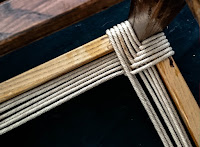... I thought this would be a good time to refurbish my poor, neglected old office chair.
When we first set up in business I bought this chair second hand, and replaced all the worn old fabric on it with nice, colourful, flowery stuff. It looked great! And for me it's been the most comfortable office chair I've ever parked my bum on.
However, a number of years have passed since then, during which the chair has had a lot of use, and it's now in a really sorry state, as you can see below.
 |
My comfy chair: BEFORE
|
I unscrewed the back, the armrests and the seat, and stripped off all the fabric and the horrid old foam. The back and seat are made from nice solid plywood, so it's a fairly straightforward job to replace the foam with new stuff.
The armrests, though, had seen better days. They're made from a type of moulded plastic with a bit of give in it, attached to a piece of plywood. One is actually broken, with a piece missing at the front, and the other is all chewed up where some previous person had tried to staple a cover on it. (I suspect this is actually the third time this chair has been recovered.)
So Steve, my brilliant partner-in-crime, has made new armrests for me, from plywood. He's even extracted the screw-in sockets to hold the bolts that fix the armrests to the arms, and fitted them into new holes in the new rests.
I've used two types of fabric for the new covers. The first is an orange, striped fabric from my stash; the other is some nice heavyweight denim from a pair of discarded jeans. I've sewn them together to produce a blue stripe down the middle of the seat and back.
Then it was just a matter of gluing the foam to the seat and back panels (using contact adhesive), covering said foam with tightly stretched lining fabric (held on with staples on other side) in order to produce a nice curved shape round the sides, and then the same again with the newly-made cover. So the back and seat look great! I'm almost tempted just to use it and forget about the armrests, but that would be cheating.
So the armrests are sitting outside on the picnic table at this very moment, waiting for the glue to dry before I put them through the same process of lining fabric, and then cover fabric. I should get them finished before bedtime! (Though there's another little problem that still needs solving, and it would help a lot if I could remember where I put that slab of Fimo about 10 years ago ... More on this later.)
I'm really looking forward to sitting on it again. The substitute chair upon which I currently sitting is not nearly as comfy.
Photos of the finished chair very soon!
And in the meantime, here's what I found underneath the seat. I guess Jim Oakes (with his nice handwriting) was quite proud of his work back in 1984. I wonder what he'd think if he knew one of the chairs he'd worked on was still in constant use all these years later, and being recovered for a 3rd time?

















